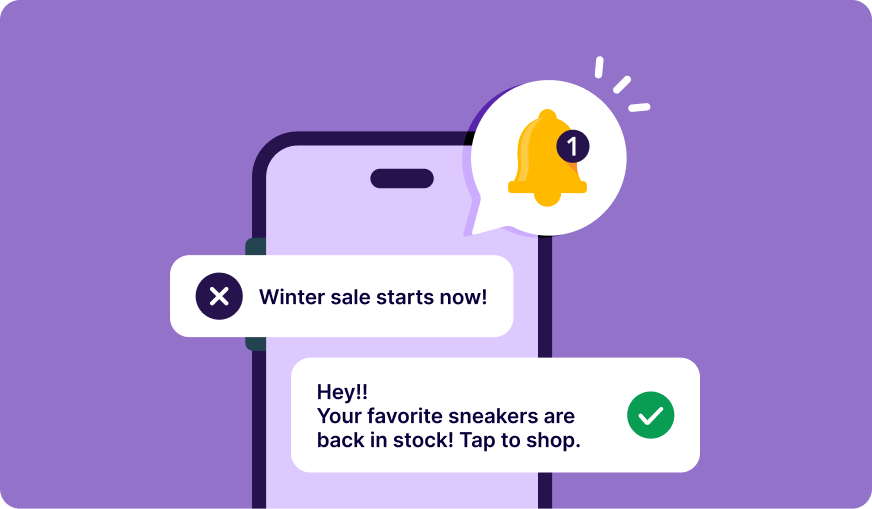Follow us and stay on top of everything CRO
Read summarized version with
What are push notifications?
Push notifications are clickable pop-up messages that appear on your users’ browsers irrespective of the device they’re using or the browser they’re on. They serve as a quick communication channel enabling companies to convey messages, offers, or other information to their customers. Subscribers can be anywhere on the browser and still receive these messages as long as they’re online or have their browsers running on their devices.
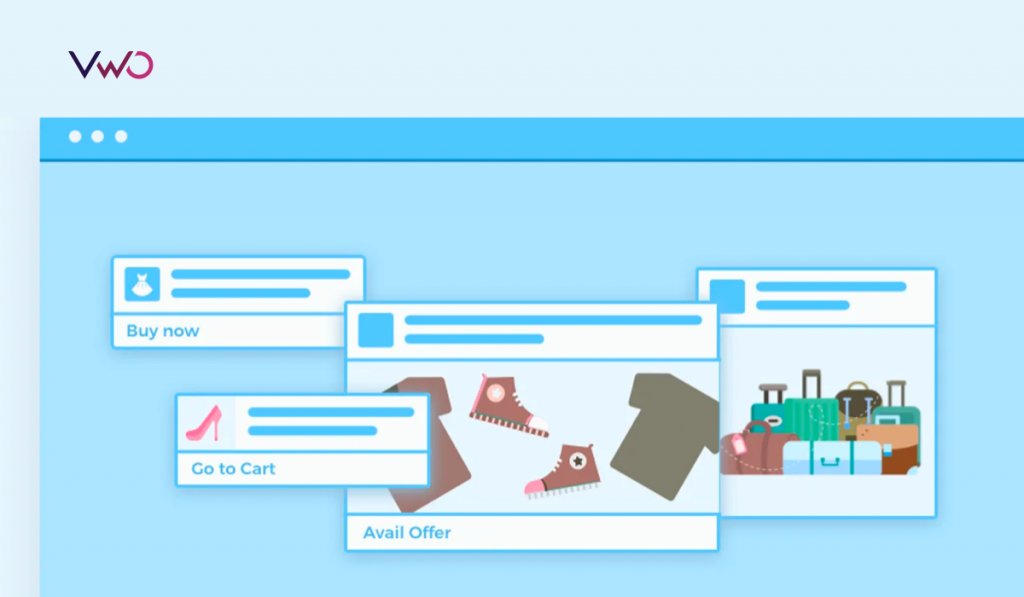
Introduced in 2009, this digital marketing channel is newer than most existing ones. Even though it has gained significant momentum over the past few years, there is still a wide gap between the strategic implementation of this newer method and others. Marketers are still discovering use cases for push notifications, but they’ve observed that push notifications do increase repeat visits, user retention, and re-engagement. This guide will tell you all that you need to know about push notifications.
The anatomy of push notifications
Push notifications are made up of several elements. They typically consist of a title, a message, an image, and a URL. Choose an image that adds context, and emojis that communicate your message in fewer words. Below is a pictorial representation of what push notifications comprise:

Write a crisp title and copy within the recommended character limit, add images or emojis to convey more with fewer words, provide the correct URL and CTA, and hit send. Your first push notification will be on its way to your subscribers.
Here’s an example of what a push notification looks like.
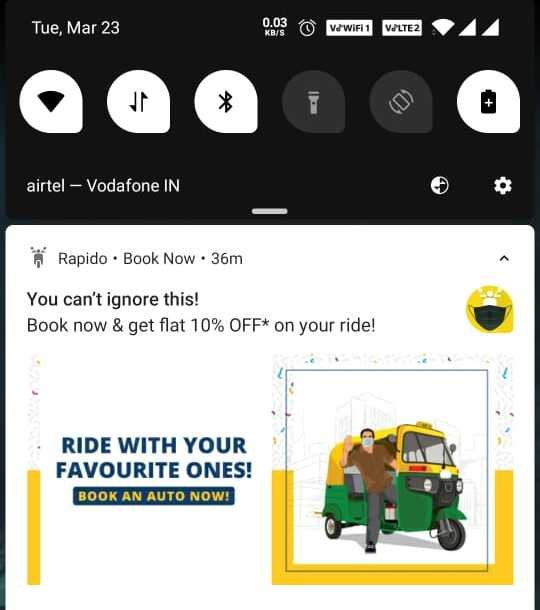
Push notifications are simple and attractive messages that are easy to respond to. This makes them an effective medium for companies to keep their audience engaged, even when they’re not on their site.
What is an opt-in message? Why is it crucial?
The opt-in message is the first notification you ever send to your potential subscribers. It determines the conversion of a visitor to a subscriber. Hence, it’s essential to communicate what value your push notifications offer.
Once you set up push notifications on your website, your visitors will begin seeing a small opt-in box on their browsers. This box asks them if they want to receive notifications from your website. As soon as they give their permission, they’re added as subscribers to your subscriber base, and you can start sending notifications to engage and target them to return to your website for more offers and actions.
Customize the opt-in message to add more context to your communication.
- Based on what your business is and who your target audience is, time your opt-in message accordingly.
- Decide if you want the permission message to appear when visitors land on your website or when they’ve engaged with your website for a certain time.
- State explicitly that it’s easy to opt-out as well. This will help to build a level of trust in your brand.

Different types of push notifications
Ideally, there are four types of push notifications – Web push notifications, Desktop push notifications, Mobile app push notifications, and push notifications for wearables Let’s learn about them in some detail:
1. Web Push Notification:
Web push notifications are communication messages sent to a user through desktop web or mobile web. These alert messages simply slide in at the top or bottom right-hand side of the desktop screen, depending upon the operating system being used by a user. Meanwhile, they appear on a mobile device that’s quite identical to how push notifications are delivered from an app. Web push notifications are usually delivered on a user’s desktop or mobile screen anytime they’re active on their browser, irrespective of whether or not they’re on your website.
These notifications are mainly used by marketers to increase website engagement and encourage visitors to keep coming back to their website, thereby increasing conversions. It’s fairly easy to build web push notifications for your website, and this can be done even by those with little or no technical background. This is what makes web push notifications such a handy tool for marketers.
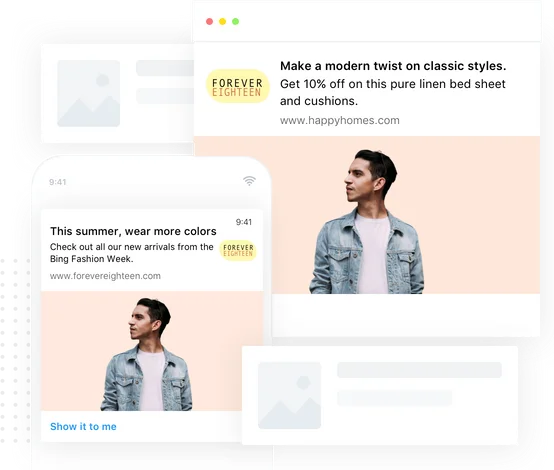
2. Desktop Push Notifications:
Unlike web push notifications, desktop push notifications appear only on your users’ desktops. These notifications are driven mainly by the products that you have installed on your desktop, with the aim of driving customer engagement. Desktop push notifications are fairly difficult to build as compared to web push notifications and require a developer’s help as well.
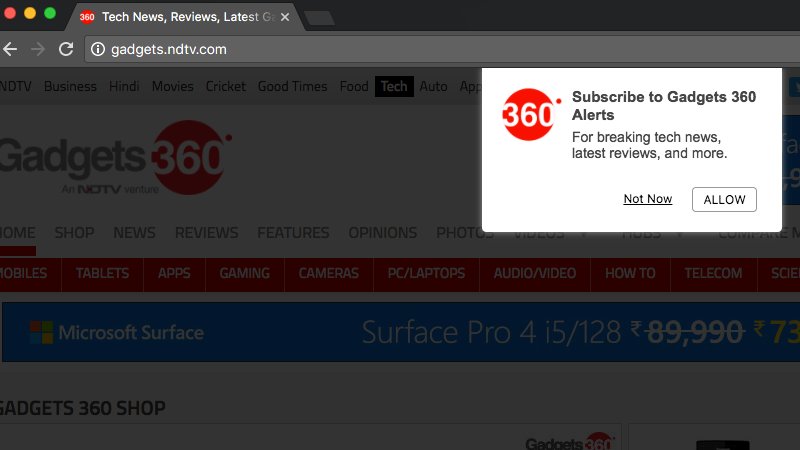
3. Mobile App Push Notifications:
Similar to desktop push notifications, mobile app push notifications are also triggered by an existing/downloaded application on your device. When a user opens the app, unique identifiers are registered for both the app and the device with the OS push notification service. These IDs are also shared with the app publishers, who then manually craft and send push notifications with the aim to increase customer engagement.
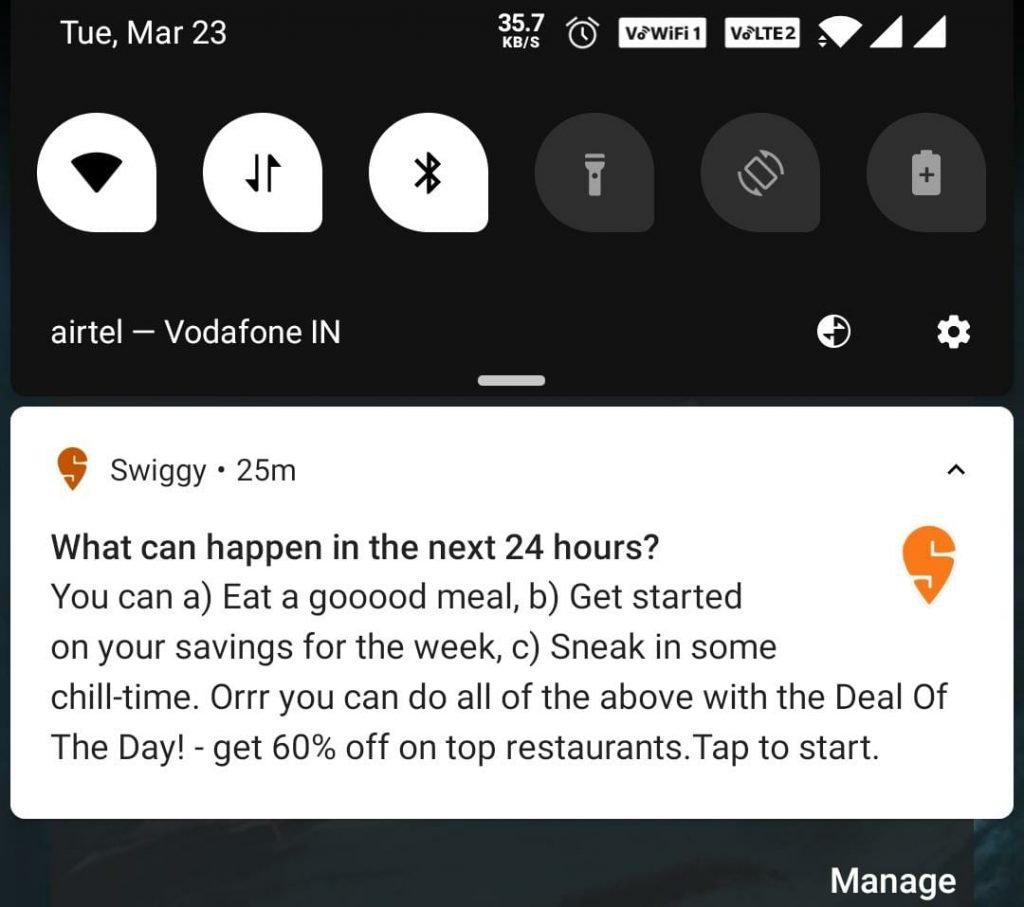
Push notification alerts can be displayed in three locations on your phone—lock screen, banner, and notification center, when the app user opts-in for messages. While Android has a default setting of opt-in and manual opt-out users, iOS does not allow apps to send notifications to users until they agree to receive messages. Mobile app push notifications, like desktop push notifications, are fairly difficult to create when compared to web push notifications and require developer help to be built.
4. Push notifications on wearables:
Push notifications can now be sent on wearable devices as well. If you’ve noticed, people wearing Smart Watches are able to receive notifications on their wearables. These devices are ideally synchronized with their smartphones allowing the wearables to display notifications directly from their mobile apps. Both mobile and wearables give you the leverage to adjust notification settings. You can opt-in to receive notifications from some apps while disabling the feature for the rest.
Since the screen size of wearables is smaller than smartphones, push notifications look quite different on the former than the latter. Notifications on wearables are shorter and more crispier than mobile notifications.

Different types of push notification campaigns
Everyone loves hand-crafted notes made especially for them. Push notifications are the closest any tech can come to that. Customers are more likely to click on messages that pique their interest and emotions. This means that there are certain kinds of push notifications that customers like receiving. These notifications keep your users interested, entertained, or even feel loved:
1. Rich push notifications
Use rich push notifications and add images, emojis and up to 2 CTAs in your notification.
- Rich push notifications are different from standard push notifications because unlike the latter, they enable you to add up to 3 clickable links on your notification – the notification itself and 2 CTAs. If you have more than one landing page where you want to send your subscribers, multiple CTAs can help you achieve that. And, it also helps you understand what kind of CTA copy users find most interesting and click on.
- You can only write so much in your push notification message. Images and videos help you provide added context to your users as well as increase the visual appeal of your notifications.
- Words sometimes fail to convey the intended emotions, especially when you have to adhere to the character limitations set by Google Cloud Manager (GCM). This is where emojis come into play. They have their own charm and influence. With an array of emojis available to be used today, your push notification can convey its theme and message with just one glance. Emojis help to ensure that your users receive notifications in the exact emotional tone you want them to. They also eliminate the use of too much text, thus conveying the exact message even to users who may not read the entire text. Plus, seeing positive emojis in push notifications urges them to click on your notification.
2. Abandoned cart push notifications
At times, a customer adds something to their cart and leaves it there for varied reasons like unexpected shipping fees, long delivery time, or payment failures. Retarget lost customers that failed to complete their purchases through cart abandonment notifications through the following ways:
- Funnel to recover abandonment cart: Schedule a series of automated notifications to be sent at the optimal interval until they complete their purchase. Set up an entry trigger for each campaign, with a set of predefined logic and conditions.
- Build unlimited campaigns: As retailers, you would prefer the flexibility and ease to set your campaigns based on different parameters that work best for you. Build as many campaigns you desire and add your prospects in the different lists you wish to target.
- Send notifications to the right target audience: Create a dynamic list of customers who added a product to their cart but did not complete the checkout process. Each campaign can have custom audiences, based on different subscriber properties, that you choose. Categorize based on their location, platform, devices, and much more.
- Track your success with engagement metrics: Don’t just get visitors back to their abandoned carts, but also keep a track of how many of them completed their purchases and converted to customers by tracking total notifications delivered, number of clicks, and the click rate for each campaign.
Want to nudge users to purchase product/s they left in their cart? Try sending them something like, “You left a few items you love. We are holding on to them, but not for long!” Action-based push notifications give users an extra push and create a sense of urgency to complete the desired action.
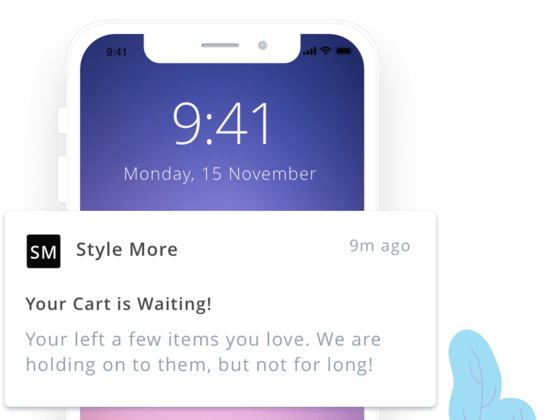
3. For-your-information (FYI) notifications
Want to let your users know about trending news on travel? Then send them this travel news alert! Similarly, you can send messages on the latest weather report, stock update, brand level changes, updates about their field of interest, and much more. If this type fits your business goals, start pushing!

4. Triggered push notifications
Enhance your buyer’s journey through triggered push notification campaigns. With triggered campaigns, you can use push notifications as a proactive medium to follow your buyer’s journey. It enables you to push a series of automated messages based on predefined rules and real-time data collected after subscribers enter the campaign funnel.
Create different types of campaigns based on your push notification marketing strategy – open-ended campaigns or closed campaigns. An open-ended campaign enables you to send a series of notifications without an exit trigger. Once the subscriber receives all the notifications in the series you’ve planned, the campaign ends. A closed campaign is where you lay out a predefined goal, and once your subscriber completes the action, they exit the campaign. They no longer receive the remaining notifications in the series.
- Personalize your automated communication: Add a human touch to your scheduled push notifications. Create different custom attributes and interact with your subscribers personally.
- Determine your target audience: Create custom target groups of subscribers if you have a specific set of audience in mind.
- Define entry trigger conditions and set goals to convert subscribers based on the page visited: This is the entry point for anyone becoming a part of your funnel. Based on the pages visited by the user, determine who is qualified to receive your series of notifications. Also, set predefined goals that act as exit points for your closed campaigns. This means subscribers convert and drop out of the campaign as soon as they hit a goal. Choose the desired final action or destination page where you want your buyer’s journey to end.
- Define entry trigger conditions and set goals to convert subscribers based on the element clicked: This is the entry point for your subscribers clicking on any particular CSS element, which includes any link or button on a specific page or throughout the website. Define the entry trigger and customize it further based on your business goals. The goal set can be defined as a click on a specific CSS element. This is the point where subscribers convert and drop out of the campaign, as they performed the desired action. You can set a payment gateway or checkout from the cart, as one of the exit triggers. This completes the campaign for a buyer journey.
- Queue the notifications: Craft a seamless buyer’s journey by queuing a series of notifications with the message you wish to convey – schedule to send them after a specified time delay once a subscriber enters the campaign. You can also assign the intervals of time between each notification to be sent.
Track each campaign with in-depth reporting: Keep a tab on the number of subscribers converted and the conversion rate. Deep-dive into each notification delivered, clicks they received, and their click rate.
5. Reminder notifications
Is a user profile incomplete on your job hunt portal? Did a user add products to your store’s cart and leave your site without making a purchase? Send them a reminder so that you as well as they do not miss out on exciting opportunities. This delights users, and they would want to remain loyal. This type of push notification is perfect for fitness enthusiasts, job portals, educational portals, nutrition sites, eCommerce stores, and many more.
6. Interest-Based Geo-location Notifications
These types of notifications are great for date match alerts, stores nearby, and lots more. For example, if you want to send your users deals on fine dining restaurants in their current location, then send them updates based on their preferences in their vicinity. Another good example where interest-based geological notifications play a critical role is dating apps like Tinder and Bumble.

7. Mobile-Friendly Push Notifications
Are your users mostly engaged on their mobile phones? Then send them mobile-friendly push notifications. Mobile-friendly push notifications allow you to send push messages right to the users’ mobile browsers without having to invest in building an app!
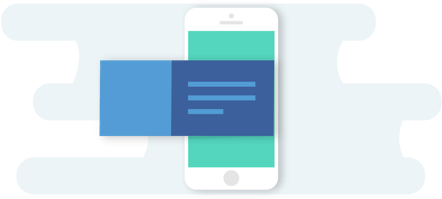
8. Time-bound notifications
Send time-bound push notifications to create a sense of urgency among users. You can send them notifications about a limited-period offer, a soon approaching expiry date, limited-period flash sales, and so on. Your users will be eager to grab the opportunity and utilize the offer.
For time-bound notifications, you have to set a notification expiry once the offer period lapses so that users who come online after its expiry do not click through to find an expired deal.

9. Transactional push notifications
Transactional notifications are a way to update your users about the latest status of their transactions. These could be subscription statuses, details of their order or product shipments, payments made, and so on.
Such messages help report the necessary and relevant information to specific users and increase the chances of planning a retargeting campaign. Transactional push notifications serve as the best examples of tailored and personalized communications with your target users.
10. User-based push notifications
Conservative estimates have pegged the click rate from push notifications at 4-8X times that of email. It is a strictly permission-based medium. Subscribers will receive notifications if and only if they have opted-in. These characteristics make push notifications an extremely powerful communication channel for marketing:

Why should you use push notifications?
Conservative estimates have pegged the click rate from push notifications at 4-8X times that of email. It is a strictly permission-based medium. Subscribers will receive notifications if and only if they have opted-in. These characteristics make push notifications an extremely powerful communication channel for marketing:
1. Offering opt-in choice:
With push notifications, you can increase your brand’s visibility among its audience by adding subscribers with a single click to ‘allow’. Give users the choice to access or deny the permission for your website to send them notifications and ensure the opt-in message conveys what type of messages they should expect. If users click on the message without knowing its end purpose, most of them will opt-out without adding much value to your entire push notification exercise.
2. Capturing increased and good quality leads:
Many businesses suffer from low lead count as well as low lead quality because visitors are often reluctant to provide personal information or one or some of the form fields make them think twice before filling the lead generation form. With push notifications, you don’t have to rely on capturing lead information as you can add subscribers with single-click permission and engage them without asking for any personal data.
Additionally, push notifications require opt-in permission, which means whenever a message is delivered, it is guaranteed to reach a real subscriber’s active browser. And since browsers like Chrome, Safari, and Firefox are used by a majority of internet users, rest assured that you will reach a wide base of interested audiences as well.
3. Increasing return traffic:
You’ve managed to get customers to your website for the first time, but how do you retain them? Compelling messages can grab your audience’s interest and engage them right away. Send proactive clickable messages directing them back to your website from anywhere on their browsers. This helps you increase return visitors through targeted notifications and personalized messages. You can keep them hooked with different promotional offers, articles, and much more to increase visitor interaction with your website. Push notification gets delivered right on the users’ browser, and enjoys a 4x CTR than emails.
4. Time-saving:
If you’re a marketer, you realize the time and effort it takes to craft a newsletter or an email. It isn’t easy to write compelling copy, articles, offers, and illustrations on the go, but this isn’t the case with push messages as these are concise and less time-consuming to compose. Mind you; they still need to be on point with a title that acts as a hook, and a resonating message.
- Connecting at the right time: With push notifications, you can materialize on existing opportunities by connecting with your users at the right time. Send real-time push notifications when you are looking for instant responses – automate notifications for campaigns, set up expiry dates for time-bound messages, set up notifications based on different geographies, and time-zones your target audience follow.
- Improving outreach: Push notifications are likely to perform better than SMS and email. People don’t have to read their SMS, and emails can end up in spam. However, this isn’t the case with push notifications since they are sent directly on your users’ desktops or mobile browsers, demanding attention.
Eliminating dependence on mobile apps: Stay connected to your mobile audience without investing in building a mobile app. They receive notifications, just like in-app, right on their Android device. They just need to have a mobile device that supports either Chrome, Firefox, or Opera browser.
How to calculate web push ROI?
As a web marketer, you should know where to invest your resources while designing your communication strategy. Web push notifications can save you money as compared to mobile app push notifications, where designing is an expensive process. Therefore, it’s imperative to know the measure of your ROI from different channels to invest wisely.
Web push ROI is the measure of performance of an investment made in web push notifications to retarget site visitors. You can calculate the ROI of your Web Push Notification investment based on the below-mentioned metrics:
- Unique visitors: This is the count of average monthly unique visitors.
- Opt-in rate: This is the percentage of subscribers who opt-in for push notifications.
- Delivery rate: This can be calculated as the ratio of impressions and successfully delivered messages to the total number of messages sent, assuming subscribers are online to receive a message.
- CTR: Click-through rate is the percentage of the measure of clicks per delivered message, assuming all clicks result in a session.
- Number of notifications: This is the number of notifications you want to push each month.
- Average order value (eCommerce): It measures the average total of every order placed over a defined period of time.
- Average monthly sessions (publishers): It’s the average amount of time a visitor spends on your website in a month.
- Conversion rate: This is the industry average. Generally ranges from 2-3%.
How do push notifications work?
At the core of push notifications services like Google’s Firebase Cloud Messaging (FCM) and Apple’s Push Notification Service enable notifications on Safari and Windows Notification Service for Microsoft Edge.
To further illustrate how these services work, let’s take the example of FCM. It’s a messaging solution that makes it possible for both mobile applications and websites to send notifications to subscribers. The application servers send the content of the notification along with subscriber information to FCM. FCM verifies the information and then sends the notification to the end-users’ devices. Upon receiving the notification, the devices send Click and Delivery data back to the application. This data helps websites and apps track the performance of these notifications.
Although FCM falls under Google’s umbrella, it also works with other browsers that support Push API like Mozilla Firefox and Opera. This enables the sending of push notifications to a web app via a push service. It also helps web applications receive notifications sent by a server.

Which browsers support push notifications?
As of now, Chrome, Firefox, Opera and Safari support push notification services. Please note that supported browsers widely vary by vendor. Further, the appearance of notifications also varies from one browser and operating system to another. Some notifications make use of traditional notification centers, whereas many others don’t. This distinction also varies from one browser and operating system to another.
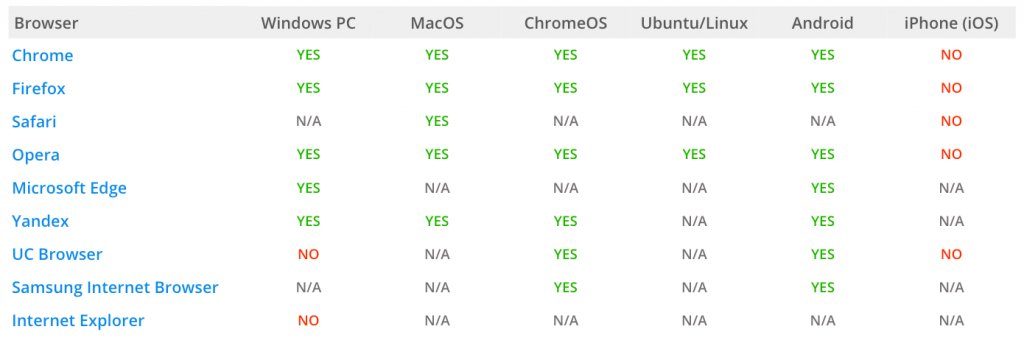
Although all major browsers support push notifications today, there are still a couple of things that you must know:
- Push notifications do not work in the incognito or private browser modes.
- Web push notifications are not supported by in-app browsers such as those present in Facebook/Instagram.
- Web push notifications do not work inside some webviews on Android.
Which metrics to track for optimizing user engagement?
After setting up your push notification system, you’d want to know if your push notification campaign is working or not. For this, you need to track more than just one metric to assess its impact across the funnel.
Listed below are some of the metrics that you cannot, and should not ignore when analyzing your campaign’s performance:
1. Opt-in rate:
The first step to ensuring the success of your push notification metric is the opt-in process. If your target audience does not opt-in to your push notifications, you will fail to build a healthy subscriber base. Track your opt-in rate to see how your audience is responding to it, and configure your push opt-in message in such a way that it resonates with your users. Give them a sneak peek into what benefits they will reap by opting-in to your push messages.
2. Browser and platform distribution:
Identify if your audience accesses your notifications either on their desktops or on their mobile devices. Not just that, have an informed understanding of the browsers that work best for your push notification campaigns.

3. Delivery and click rate:
Your goal isn’t simply to send push notifications but to ensure that it gets delivered to a larger subscriber base. Analyze the performance of your latest notification by tracking the delivery rate and click rate of your notifications. These stats tell you how many subscribers opened the notification from the number of successfully delivered campaigns and is also a good metric to gauge the content quality of the notifications. You’ll see an increase in the number of clicks when you send notifications that interest specific user segments. It also denotes how many users have opened your messages and reached the landing page.
4. Conversion rate:
Conversion rate is the percentage of visitors who engaged with your website and performed the desired action. It can be anything from making a purchase or referring a friend to signing up or reading a blog post. Your conversion rate gives you a clearly painted picture of how your push notification campaigns are performing.
When tracking the conversion rate, it is important to figure out which source is bringing the most traffic to your website, and which segment of traffic is converting the most. This can be done by setting certain UTM parameters to your push notification campaigns.
This will enable you to identify sources that are performing well, those that are performing below par, and figure out ways to improve each of their performance with in-depth analysis.
This science of optimizing conversion rate is known as conversion rate optimization(CRO).
The elements of a good push notification strategy
Yes, push notification is newer than most existing channels of digital marketing. Yes, it has gained significant momentum over the last few years. And yes, it enjoys 4X the CTR of emails. But this doesn’t mean that by simply leveraging push notifications, you can shoot up your core business metrics. For push notifications to work, the entire journey starting from crafting the messages to sending them should be carefully planned and embarked on. Let’s look at some of the most common elements that make your push notification strategy a good one:
1. Craft compelling content
Make sure you write the content according to your target audience. Know what questions your ideal audience is asking, and put out content that answers them. You can also use visuals to make your content more comprehensible. Any amount of advertising won’t help much if the content is not good itself. So make sure you write persuasive copies for your push notifications to get noticed, keeping the following points in mind:
- Craft a clear and crisp message: Do more than just tying together fancy words. Write your notification message keeping in mind your target audience. Avoid using jargons, go for simple and direct language, and keep your users hooked with catchy one-liners and CTAs. The message should easily convey what the notification is about, and tell users how they will benefit from clicking on the notification.
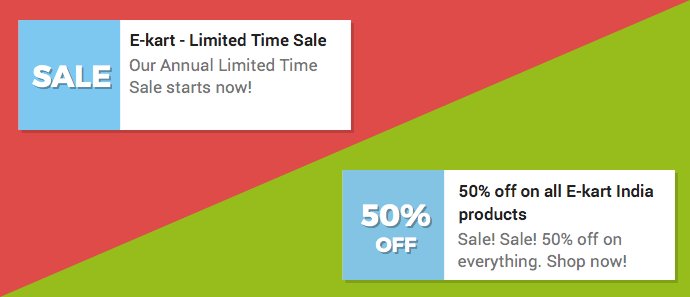
- Use scarcity to create urgency and FOMO: Create a sense of urgency by tempting users to click the notifications related to certain actions. Clearly convey what the users should do next if they intend to get a discount from your website or download a report that you’ve published. An action-oriented copy prompts users to take action. This gets more responses and conversions compared to a normal copy.
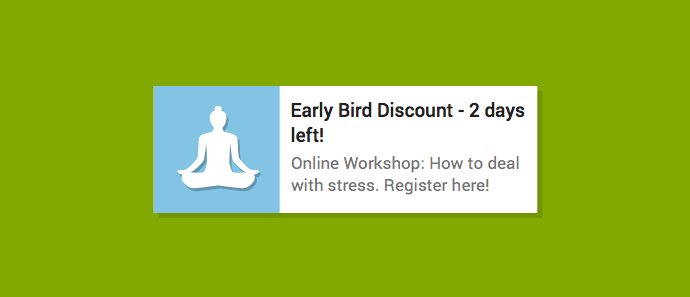
2. Leverage your existing subscriber base
If you have a good number of email subscribers, you can even embed a link of your triggered webpage in your email newsletters and redirect your email subscribers to a page where they can opt-in to receive push notifications.
3. Use social proof
Represent your brand on multiple social media platforms, and build an engaged audience. You can then provide a link to your page with the opt-in trigger in your profile’s bio, as well as run other marketing campaigns and advertisements. You can also add a statement mentioning your products or services’ performance and satisfaction level attained by existing users.
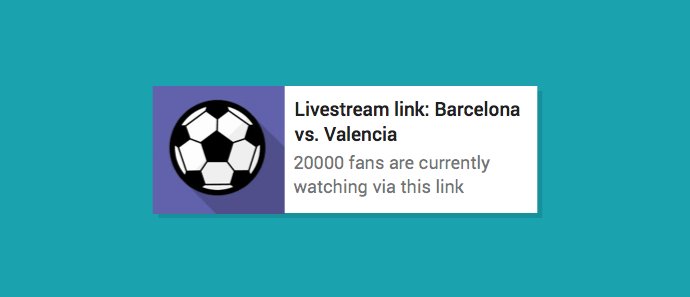
4. Send the right kind of notifications
You can send a notification that is informative, time-bound, or simply a reminder. With A/B testing, find out which type of push notifications engage your target audiences more, and best suit your business and user needs. This is important because you should send messages that your specific users prefer. Also, consider the type of products or services you have to offer. Make sure your message depicts the right emotion(s). Spread out your notifications according to the nature of your content.
5. Segment and customize
It has been found that common messages broadcasted to all the subscribers result in lower engagement. Adding a personal touch to your marketing plan always takes you the extra mile. Identify the parameters that would help you segment customers and then send specific pushes to the right segment, thereby increasing engagement.
6. Offer easy opt-in and opt-out options
Push notifications are a strictly permission-based medium, and the opt-in acts as the first touchpoint with a new visitor. Similarly, these notifications ensure that it isn’t difficult to opt-out either. This way, the subscriber feels empowered to have the choice of receiving or avoiding messages, and you get to target only the interested prospects.
Experiment with the timing of your opt-in message – it could be after 10 seconds of engaging with your website, or it could be immediately upon landing on your webpage. Integrate with an A/B testing tool to test and identify what kind of push notification works best with your target audience.
The opt-in message is the most important of all the notifications you will ever send. It determines the conversion of a first-time visitor to a subscriber. Hence, it’s important to communicate what value your push notifications offer.
Once you set up push notifications on your website, your visitors will begin seeing a small opt-in box on their browsers. This box will ask them if they want to receive notifications from your website. Once they give their permission, they are added as subscribers, and you can begin sending them notifications to engage and target them to return to your landing page.
Customize the opt-in message to add more context to the messages. Based on what your business is and who your target audience is, time your opt-in message. Decide if you want the permission message to appear when visitors land on your website or when they have engaged with the website for a certain time. Also, state explicitly that it is easy to opt-out as well. This helps in building their trust in your brand. Learn how to create your push notification opt-in strategy.
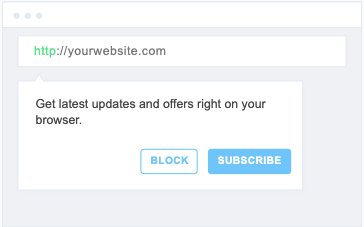
Common mistakes made while using push notifications
Push notifications are an exceptionally handy tool to engage your audience in real-time, and in a very personalized manner. A robust push notification campaign helps increase repeat visits and direct traffic to best-performing content. Sounds exciting, right? It surely is!
However, many websites are not able to reap all the potential benefits of push notifications due to certain easily fixable mistakes. Here’s a list of few mistakes you should avoid while setting up push notifications for your campaign:
1. Sending too many notifications:
The most common mistake, and the most damaging one from a long-term point of view, that you can make while sending push notifications is inundating your subscribers with notifications. This might look beneficial in the short-term, where you see an overall increase in the numbers. But, using push notifications like this will prompt more and more subscribers to opt-out.
Push notifications are a great way to talk to your audience directly and in real-time. The downside of this is that too many direct conversations with subscribers may lead to “notification overkill” and may result in subscribers either tuning out mentally or opting-out altogether.
The flip-side to this is sending too few notifications. This can result in subscribers failing to engage with your brand properly or may have trouble remembering why they subscribed to your notifications. As a business, you need to understand your audience, their lifestyles, and their needs to figure out the frequency of your push notifications.
Note, push notification frequency varies from case-to-case, which is why you need to be more selective with what messages you are sending via push notifications.
2. Not automating notifications:
If you do not plan and automate your push notifications, chances are that your subscribers will receive them at odd hours, and this may cause friction between your users and your campaign.
Schedule your notifications for a certain date and time, or based on the time-zone of your audience segment. Plan it in a manner that users don’t receive them at odd hours or disrupt their productivity. Test out the best time of the day to achieve maximum engagement. Your strategy differs based on your business offers. Poorly timed push notifications are a sure-fire way to exasperate your subscribers, leading to fewer clicks and a higher opt-out rate.
A well-timed push can lead to a user’s delight. Imagine getting a notification that reads “10 Amazingly Inspirational Songs To Start Your Day” as you are preparing to go out for a run at 7 AM. A small change in the schedule can significantly impact your overall push notification strategy.
Scheduled notifications are time-savers for sure, and have a plethora of benefits too:
- Be in two places at once: Suppose you have to attend a conference next month. You have many things to put in place and also prepare for the event with the thought of sending marketing messages to your users lurking in the back of your head. This is where you can use push notification automation. Simply schedule your push notifications in advance and rest assured. The notifications will automatically get delivered to your target audience on the scheduled day and time. So, while you may be busy listening to the speakers at the conference, your scheduled push notification about where to find your company’s kiosk at the venue will be delivered to your users.
- Time your offers right: You can schedule a series of notifications that inform and excite your subscribers of an upcoming sale or event. Then, as the sale or event progresses, schedule to send urgency-based notifications that really harness the power of FOMO, like, “Time to panic. Today is the last day of the sale!”
- Get rid of unread emails: With push notifications, you do not need to worry about your time-bound promotional emails to lay unread in your users’ inboxes. Get more people to participate in your sale with scheduled push notifications, without forgetting to send them manually later.
- Align notifications based on time zones: Schedule notifications according to the time zones your subscribers reside in to reach them when they’re active on their devices.
- Drive conversions by piquing your subscriber’s curiosity: Scheduling push notifications is also an impressive hack to promote an upcoming or even an ongoing deal, product, or feature on your website. Not only do they grab attention instantly, but they also create curiosity and excitement about what you’re promoting. For example, you can set a series of push notifications at well-planned intervals, before the launch and up to the end of the event. You’ll see more and more returning traffic on your website, eager to get more information and even make purchases.
3. Not sending onboarding notifications:
Familiarize new subscribers and customers with your website with your welcome drip push notifications. Onboard them with a series of notifications sent at different time intervals to let them explore different sections of your website. Create an onboarding funnel to keep them engaged, setting up a welcome journey that works as part of your goal.
4. Following the ‘spray-and-pray’ approach:
Every person is different. Seeing your audience and subscribers as a homogeneous mass is a classic mistake that most marketers have been guilty of committing at one time or another. However, users expect and demand high levels of personalization. Not catering to users’ preferences will only lead to notification blindness.
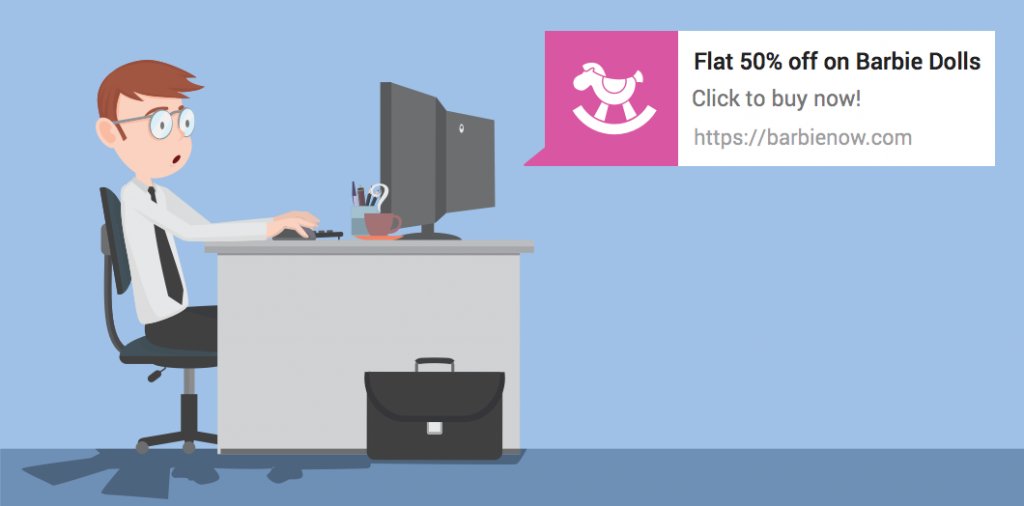
Segment your audience based on different interests and actions, and also create a target audience persona to segment them accordingly. Send only relevant messages to your subscribers based on their behavior or attributes. Offer them value-based messaging to entice them into clicking and engaging with your website. If some segments of subscribers do not find your messaging appealing enough, this will affect your entire roadmap of using push notifications. Therefore, it is absolutely important that you segment your audience and deliver personalized notifications for each segment.
5. Not tracking the right metrics:
If you’re only tracking click rates, you’re missing out on the actual conversions and value created by your push notification campaigns. As marketers, we tend to focus too strongly on immediate numbers. However, we need to be wary of vanity metrics that do not help us in making business decisions.
Decide on the website actions that you consider most important – purchases, free trials, form fills, ad clicks, and so on. Carefully sift through the data in Google Analytics or other analytics tools to find out how many of your website visitors, arriving via push notifications, are actually performing those actions. Evaluating your campaigns like this is the only way you can truly determine whether push messaging is working for you or not.
If you have a mobile app, complement your mobile push notifications with website or browser push notifications. If you don’t have an app, don’t invest in building an app just to send push notifications. Rather, use your visitors’ browser to send notifications.
In fact, some reports say for small and medium-sized businesses, mobile websites reach more people than apps do.
|
Do’s of push notification |
Don’ts of push notification |
|
|
Segmentation in push notifications
Segmenting your audience plays a significant role in your marketing strategy. Categorize your subscribers and send relevant content based on user actions or attributes. To reap the maximum benefit out of your push notification campaign, choose a tool that allows you to segment based on:
1. Page visits:
The easiest way to find out your user’s intent is through their site behavior. Categorize them based on various actions performed during a page visit, to deliver personalized messages. Segment them based on the page URL they visit, the referring URL, search keywords, referral types, query parameters, and much more.
2. Element clicked:
Curious to know how your subscribers are interacting with your landing pages? Just segment them based on the clicked element. This helps in categorizing them based on different click events, especially for instances like cart abandonment or engagement with specific CTA buttons.
3. Subscriber properties:
Segment your subscribers based on different user properties. Target them based on their Operating System, Platform, Browser, or User-Agent. This makes it easier to identify the correct fit for your business goals.
4. Geo-location:
Planning a special campaign for specific geo-location? Make your task easier by segmenting your audience based on specific countries, and even further by region. It’s easy to include or exclude any country or region, based on your business requirements. Start creating segments and trigger notifications according to your business time-zone and region, just the way you desire.
5. JavaScript/API and cookie:
Good push notification tools give you the option of creating your own customized segmentation. If you are a developer, you can segment your subscribers based on the JS/ API variables in your code. Not just that, you can also manage it based on the Cookie key and value pair stored by your website on the user’s browser.
Push Notifications in Popular Industries
Push Notifications are mainly used for re-engagement, retention, and promotions. This makes them the most preferred marketing automation channel for media publishers, bloggers, and eCommerce industries. They aren’t, however, restricted only to these domains, and have been found to yield positive results across many different industries. It is possible to see how various industries have managed to gain a foothold using push marketing over time.
For any given industry, there is an uncomplicated way to plan successful push notification campaigns:
- Identify the role of push notifications in your marketing strategy
- Segment your audience
- Set the opt-in trigger, and craft the first message
- Add good visuals to your push messages and amplify its appeal
- Schedule your notifications, and time them well to keep their frequency and timing under check
- Offer special incentives to drive more traffic
Push notifications in eCommerce
More than 22% of push notification users are in the eCommerce industry. Notifications are commonly used to promote sales and time-sensitive deals, announce new products, and deliver personalized promotions. They are also used to remind the user about an abandoned cart or to upsell or cross-sell in various situations.
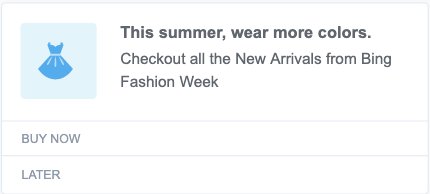
Buy Whole Foods Online, a leading seller of whole foods, health foods, and superfoods in the UK and the rest of Europe decided to give push notifications a try to bring customers back to the website and to guide them to correct product pages. This is their most popular push notification:
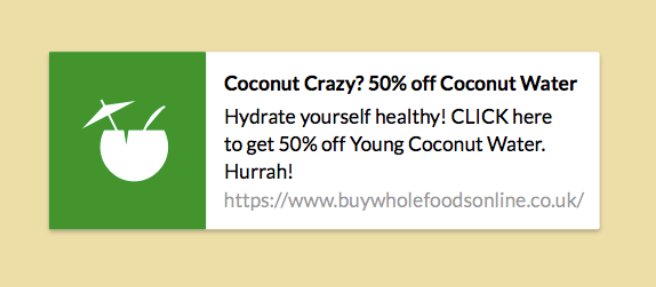
This particular notification recorded a click rate of 15.2%, and 71 out of the 97 people who landed on the product page after clicking on the push notification actually converted and made a purchase. This tiny box of push notification helped Buy Whole Foods Online clock a 3-digit revenue.
Push notifications in gaming
A huge proportion of the world’s population uses their computers, mobile phones, and tablets to play games on a regular basis. So, how can you tap into this audience to increase traffic on your gaming website? A few years back, an email would have been the answer, but not anymore. Now, we have a much better alternative – Push Notifications.
So you have this cool new online gaming community page that you know will be a game-changer. But, no matter how many promo offers and gift packs you send, you are not getting enough traffic. The prognosis could be devastating if not taken seriously, and your website could slowly fade into oblivion. To prevent such blows, you need to keep your readers and customers engaged, and make them return to your website.
Ubisoft, a renowned name in interactive entertainment and services with a grand portfolio of world-renowned brands in gaming, turned to push notifications for help with their digital marketing strategy. The team at Ubisoft wanted to find smarter ways to give quicker updates about various games to its subscribers. This was because visitors primarily came to their website to find more information on particular games that the company offered. After much research, the team decided to go ahead with push notifications. This is what Ubisoft’s push notification opt-in looked like:

After using push notifications, Ubisoft’s website registered an average click rate of 7%. The team then went on to use push notifications for game announcements and witnessed an astonishing click rate of 31%.
Push notifications in education
Education and training websites can use push notifications to connect with their subscribers online, send updates to existing students in real-time, or you can nudge potential users to learn and engage.
With push notifications, online learning website can:
- Encourage a revisit to your page with mock tests or interesting facts
- Re-engage with online learners by giving them valuable information and course updates
- You can enhance their experience by delivering information like key strategies, tips, interviews, etc.
- Once someone has completed a course, they won’t visit again. You could promote other courses to get them back
Within the character limit, you need to learn how to craft a persuasive push notification. In doing this, personalization is key. Yes, and you could also re-engage your users by asking questions.
MyEnglishTeacher.eu, a website that offers one-to-one English lessons through various mediums like skype and live chat rooms, and resources like quizzes and videos to their students, got started with push notifications with the single aim to reduce the time spent on writing and designing marketing communications.
MyEnglishTeacher.eu aims to help people from all over the world gain fluency in English. Here, take a look at what they did to win 160 subscribers in one day:
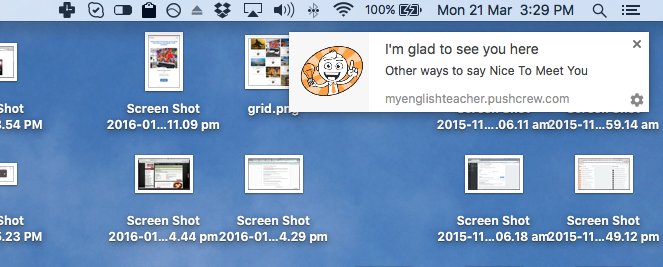
Push notifications in cosmetics
The subscriber list for your makeup and beauty website is growing, and you are publishing new content often or adding new products and have discounts for some. You are also sending email newsletters about the same. But, think about how many of them open their inboxes and read those posts, among all the other emails lying unread in their inboxes. It is a daunting task. This is why push notifications, as a channel of communication, effectively help you bring your subscribers to visit your site instantly.
Inform your audience about new products or other such information using push notifications.
Another way Cosmetics websites can use push notifications to increase engagement and grab users’ attention is by welcoming the subscribers with a welcome notification that warms up their hearts and makes them proud for choosing to go for products that are cruelty-free. Use a personal tone that will help you build a good rapport with your new subscribers.
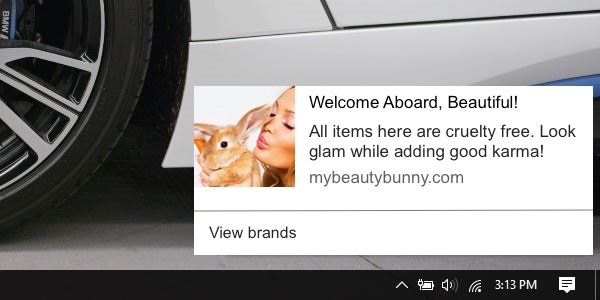
Push notifications in travel and hospitality
The travel and hospitality industry has seen a recent boom in the usage of notifications, both mobile and web – whether they be reminders to check-in or announcements about scheduling changes, push notifications allow businesses to keep customers updated with timely, crucial information. Triggered campaigns can be set up to help customers by reminding them about deals and booking offers, or to upsell or cross-sell based on their recent transactions.
LA Tourism, the official tourism marketing organization promoting Los Angeles as the premier destination for meetings, leisure travel, and conventions, started using push notifications to grow their website traffic, and increase customer engagement and retention. By segmenting the audience, LA Tourism managed to increase click-rate by 8% and reduced the bounce rate by 43%.

In another instance, if a user is looking for cheap flights to Prague on your website, send them a personalized push message about the top 10 backpackers hostel in the city. It’s a way of telling them that you foresee and understand their needs.
Push notifications in job portals
Finding the right market while building a website can be difficult. But the intelligent few who saw the growing number of job opportunities and the alarming unemployment rates came up with the idea of job portals. However, the tribe has now grown and multiplied. And with this, growing and retaining users on your job portal has become a very challenging task.
As simplistic as it may sound, practicing a good push notification strategy can help you bring in twice the amount of traffic to your website. But that does not mean you just spray and pray that it would bring you results.
Make sure you segment your users and send notifications that entice them to perform the desired action. For instance, when you are sending out a push notification about a recruiter looking for candidates, you could add a button that takes users to the recruiter’s website and another button that takes them directly to the application form.
You can also go that extra mile to customize and personalize your push notifications according to your users’ browsing activities:

Push notifications in health and fitness
The global fitness and health club industry generates more than 80 billion U.S. dollars in revenue per year. From adopting healthy lifestyles, which include eating healthy to working out, people are ready to shell out more money to look after themselves and their loved ones.
If you have a website related to health and fitness with a growing subscriber base, you’re also aware of the rising competition, trying to lure your subscriber base to their product or service.
The best way to cushion this blow is by keeping your subscribers engaged with your website. But the stage of technological progress that we are at, people neither have the time nor the intention to read promotional emails. This is where web push notifications are a gem – as an effective channel of communication. Have a new post on swimming styles for achieving toned arms? Then send your subscribers a push notification like the one shown below:
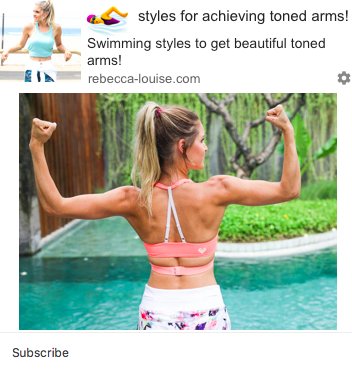
Create a sense of excitement among your users by sending welcome push notifications with exciting offers. Here’s an example for your reference:
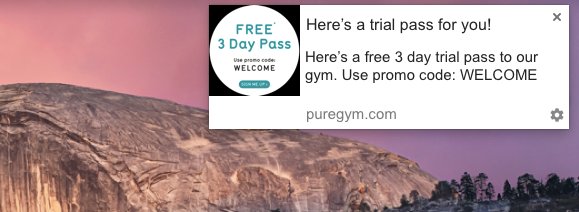
Conclusion
Push notifications send direct messages to your visitor’s browser, widen your online reach without straining to capture details through lead forms, and let you connect with your subscribers easily through a single click opt-in. We hope that the stats above and this guide help you create an effective push notification strategy, build apt messages, and choose the right kind of push notification tool for your business.
If you find this guide useful, share the word with your friends and colleagues and bring them a step closer to achieving their business goals by using push notifications.
Frequently Asked Questions on Push Notifications
Push notifications are used for multiple reasons. They are commonly used for increasing return traffic, capturing good quality leads, and improving outreach campaigns.
Yes! Push Notifications can be a very effective channel of communication. Push Notifications get delivered directly on the users’ browser. If done right, they can have a CTR as high as 4X than emails.
Enabling Push Notifications means that customers who have opted-in to become part of campaigns, and business owners would be able to reach out to these customers through push notifications.
Push Notifications is an example of sending content that appears in the form of a pop-up on your screen.
Text Notifications is an example of sending a piece of content that appears in messages inbox in mobile because of your connectivity with the cellular network provider.


